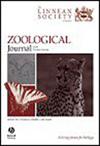Out of the darkness - a new genus of Paederinae from the Neotropics (Coleoptera: Staphylinidae) and its phylogenetic position
IF 2.8
2区 生物学
Q1 ZOOLOGY
引用次数: 0
Abstract
We describe a new genus of Paederinae rove beetles, Karillantu gen. nov., which occurs only in the Neotropics. The genus accommodates Lathrobium macrocephalum Sharp, 1876 as a type species Karillantu macrocephalus comb. nov., originally described more than 100 years ago. Intense surveys across museum collections allowed for describing eight new species: Karillantu amazonaensis sp. nov., Karillantu ecuadoriensis sp. nov., Karillantu lauretensis sp. nov., Karillantu napoensis sp. nov., Karillantu obidensis sp. nov., Karillantu paraensis sp. nov., Karillantu pastazaensis sp. nov., and Karillantu peruviensis sp. nov. We provide descriptions of the genus and species, a redescription of Karillantu macrocephalus comb. nov., an identification key, and a distribution map. To determine the sister-group relationships of Karillantu gen. nov., we conducted a phylogenetic analysis based on seven gene fragments, resulting in the largest Paederinae phylogeny up to date and a hypothesis about Karillantu gen. nov. placement. The analysis resolved the genus within the tribe Lathrobiini, nested in the informal clade of genera traditionally assigned to the subtribe Lathrobiina. We also provide information on the phylogenetic position of 17 newly sequenced taxa expanding our understanding of Paederinae relationships. The present research underscores the importance of museum collections in studying biodiversity of poorly-known groups, especially in the tropical regions.从黑暗中走出来——新热带蝶蝇科一新属(鞘翅目:蚜蝇科)及其系统发育地位
我们描述了一个新属的Paederinae rove甲虫,Karillantu gen. nov.,这只发生在新热带地区。本属的模式种为大头Lathrobium macrocephalum Sharp, 1876。11月11日,最初描述于100多年前。通过对博物馆藏品的密集调查,描述了8个新种:Karillantu amazonaensis sp. nov, Karillantu ecuadoriensis sp. nov, Karillantu lauretensis sp. nov, Karillantu napapoensis sp. nov, Karillantu obidensis sp. nov, Karillantu paraensis sp. nov, Karillantu pastazaensis sp. nov和Karillantu peruviensis sp. nov。我们提供了属和种的描述,以及对Karillantu macrocephalus comb的重新描述。11月,一个识别钥匙,和一个分布图。为了确定Karillantu gen. nov.的姐妹群关系,我们基于7个基因片段进行了系统发育分析,得到了迄今为止最大的拟蚊科系统发育,并对Karillantu gen. nov.的定位提出了假设。该分析解决了部落Lathrobiini中的属,巢在传统上分配给亚部落Lathrobiina的非正式属分支中。我们还提供了17个新测序的类群的系统发育位置信息,扩大了我们对羽科亲缘关系的理解。目前的研究强调了博物馆收藏在研究鲜为人知的群体的生物多样性方面的重要性,特别是在热带地区。
本文章由计算机程序翻译,如有差异,请以英文原文为准。
求助全文
约1分钟内获得全文
求助全文
来源期刊
CiteScore
6.50
自引率
10.70%
发文量
116
审稿时长
6-12 weeks
期刊介绍:
The Zoological Journal of the Linnean Society publishes papers on systematic and evolutionary zoology and comparative, functional and other studies where relevant to these areas. Studies of extinct as well as living animals are included. Reviews are also published; these may be invited by the Editorial Board, but uninvited reviews may also be considered. The Zoological Journal also has a wide circulation amongst zoologists and although narrowly specialized papers are not excluded, potential authors should bear that readership in mind.

 求助内容:
求助内容: 应助结果提醒方式:
应助结果提醒方式:


